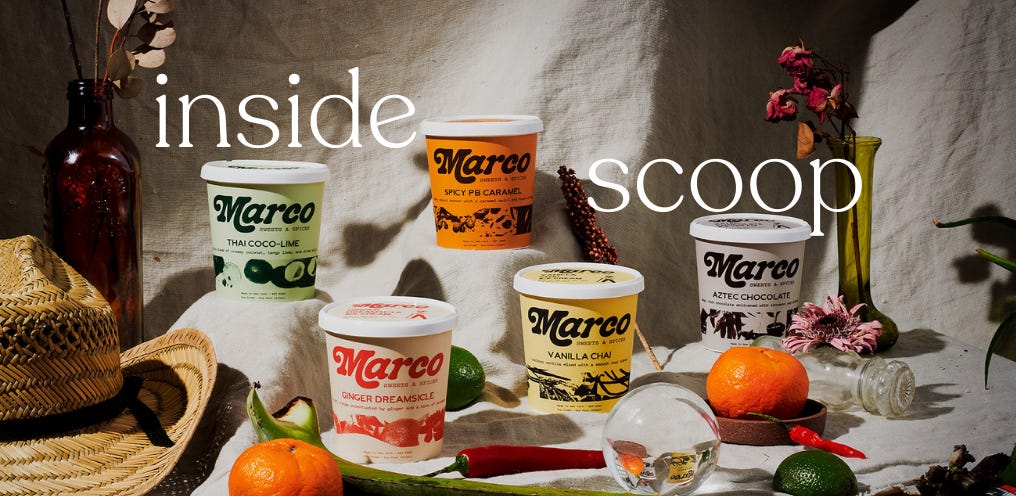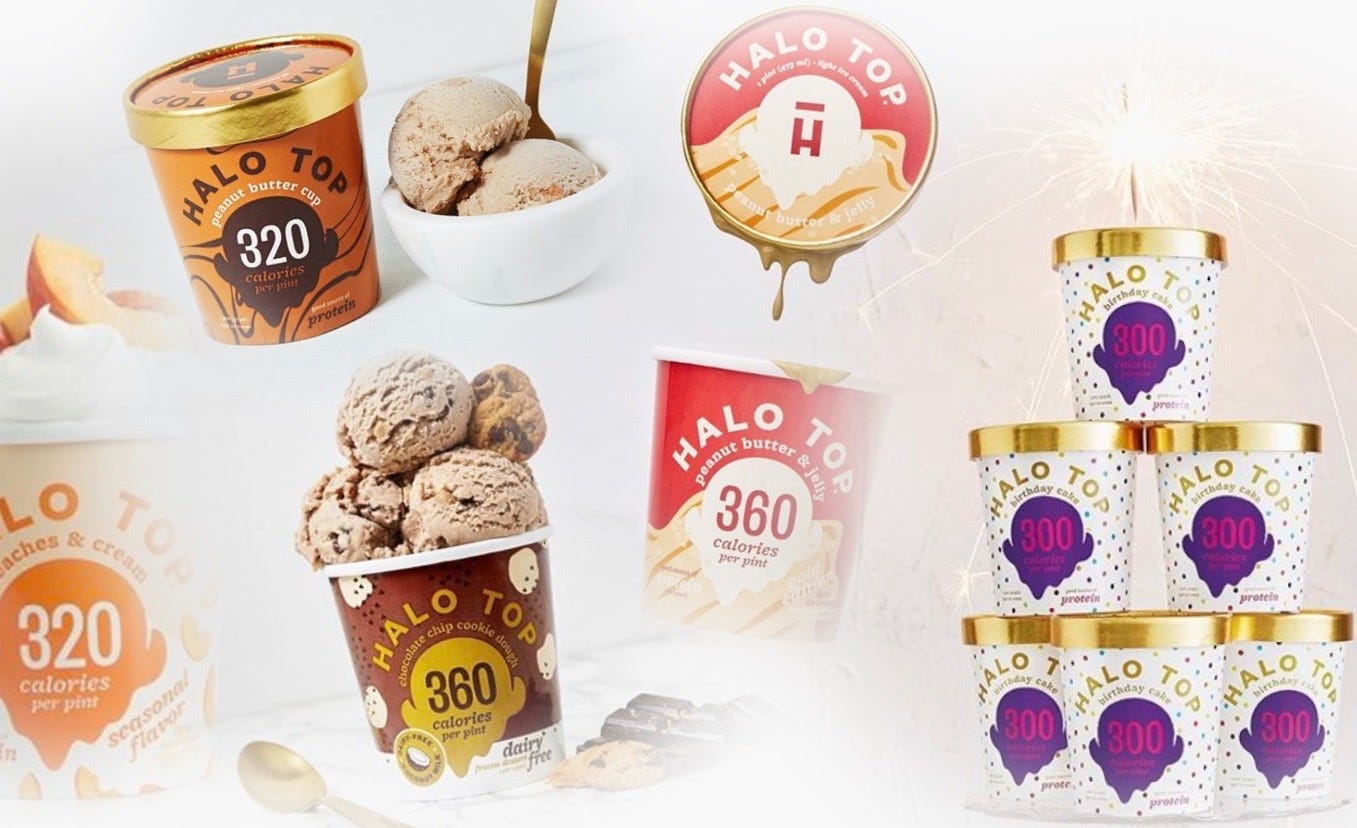A newsletter on upcoming food and beverage trends that offers a curation of brands and aesthetics written by Andrea Hernández.
You can support Snaxshot monthly now!
🔮 Peek into the future:
What makes this business so lick-rative?
Snaxshot of market + who’s making moves.
Halo Top freezes out the competition.
Favorite brands in the space.
Market challenges + opportunities.
Don’t be shy, the water’s warm, don’t forget to hit the subscribe button below.
Screaming (Internally)For Ice Cream 🍦
Nothing evokes a palette nostalgia like a spoonful of ice cream and we’ve gone from Blue Bell to the faux-ropean brands like Häagen-Dazs, to letting ourselves be tempted by the comfort of Ben & Jerry’s to now indulging in ultra-premium brands for the sake of authenticity, transparency and mindfulness.
Brand’s like Halo Top reminded us that we can have our ice cream and eat it too — Jeni’s told us $10 pints are worth it, emerging brands like Wonderlab’s Doozy Labs and Coolhaus are convincing us functional, plant-based ice cream is the way to go.
Both legacy brands and newcomers are eager to capitalize on our cabin fever as we’re forced to cope with a pandemic, a looming recession and what not—while trying to remind us that so long as we have ice cream, things can’t really be that bad?
Lick-rative business 🤑
—The US ice cream market is projected to grow with a CAGR of 2.83% during the forecast period, 2020-2025.
—This year, frozen desserts have exceeded $100 billion in sales globally this year, a category dominated by ice cream.
—Innovative flavors and formats as well as growing demand for plant-based desserts are key factors driving increase in demand.
—New products and brands are tapping into the “better-for-you” claims trend using label like “good source of protein,” “vegan” and “low glycemic”—these claims are now driving the highest dollar sales in ice cream category.
—Halo Top has become one of the biggest ice cream brands, with a 3.7% market share.
No Dairy, No Problem? 🐄
—Between 2016-2018, retail sales of nondairy ice cream increased by nearly 50%.
—In 2019, the sales of non-dairy ice cream amounted to approximately $336 million.
—Cashew and coconut milk are most common replacements in ice cream brands, though coconut milk based ice cream dominates with market share of 37.4%
The Pints Are Changing 🍨
—Ben & Jerry’s receives gluten-free certification, currently for 10 flavors and more incoming in 2021.
—Häagen-Dasz now offers lighter ice cream options with fewer calories and less sugar
—Back in 2018, Unilever launched Culture Republick as a way to compete with Halo Top.
—Heinz thought its UK customers would enjoy “Creamz” mayo flavored ice cream flavors launched earlier this year.
—Earlier this year, Blue Bell agreed to plead guilty to two misdemeanors and pay $19.3 million in fines for shipping contaminated ice cream during a 2015 listeria outbreak that left three people dead.
—ICYMI, Baskin Robbins launched an ice cream pizza for delivery earlier this year.
Cream of the Crème 🏆
Halo Top is known as the low-calorie, ice cream brand that paved path for newcomers hoping to disrupt legacy brands such as Ben & Jerry’s and Häagen-Dasz, their secret? Filling the gap between available products and change in consumer demand —Halo Top was the first to offer indulgence of premium ice cream with a lot less sugar and fat that traditional brands.
Bootstrapped in 2011 by two former lawyers, they finally broke through into mainstream and by 2016 they’d reach sales of around $44 million and more than triple their sales the next year, at $350 million. By the end of 2017, they were the best selling pint in the US and since then have remained in the top three best-selling pints with Ben & Jerry’s and Häagen-Dasz.
Halo Top shook an industry that was in desperate need of disruption as millennials came of age, searching for healthier options as well as innovative flavors. They also successfully leveraged digital channels to grow their sales, initially shunning traditional media and instead opting for targeted social media ads, with tremendous success. They are a prime example that it pays to position yourself as trendy amongst young consumers.
They’ve recently released more plant-based offerings as well as a new line of larger, ice cream pops.
Brands We Melt For 😋
Marco: They focus on “culinary flavors” from around the world. Some flavors include Aztec chocolate and Spicy PB Caramel. Love their tagline —"the hottest thing to hit your freezer.
Sunscoop: Based in NYC, this brand is both vegan and gluten-free and female founded! What I love about their brand is that it uses functional ingredients as well!
Eclipse Foods: Launched in 2019 in the Bay Area, they makes ice cream products that are “indistinguishable” from the real thing. Raised $12 million in Series A funding by the likes of Forerunner Ventures and Alexis Ohanian. Secured retail distribution throughout California and will be using funds to expand its line of dairy-free offerings, from cheese to cream, to rival taste, texture and experience of real dairy.
Brave Robot: Another vegan option, their branding is very Y2K-ish meets 3D, they claim their flavor descriptions are funny but I would love to have a word (no pun intended) with their copywriting team —I volunteer my wit as tribute. Remind me to ask Nate Rosen from Sustainable Snacks what he thought of them.
Moody’s: By far my favorite in terms of branding and offerings as their flavors combine herbs and other functional ingredients that aim to be complementary of moods as well as mood boosters, which is inherently the sole mission of ice cream IMO.
Swirl: Based in Montreal, their minimalistic branding is wonderful, as well as their flavor offerings including hibiscus (you already know what I think of this) sweet corn and marshmallow!
Nora’s: Made in Vancouver, they’re a plant-based brand that knows how to rock a Millennial pink and GenZ yellow (otherwise known as pastels) —a fan of their product styling!
Wonderlab’s Doozy Pots: Made using sustainable practices, their gelato’s are vegan, made with hemp, oats, less sugar and less saturated fats than traditional brands.
CoolHaus: Female founded, they’re not only known for their pints but their drool-inducing cookie sandwiches.
Sacred Served: Another plant-based gelato made with coconut, superfoods, adaptogenic herbs, and low-glycemic coconut sugar. What makes them unique is their cube like packaging!
Morgenstern’s: Based in NYC, they ship over 88 flavors across the US. They’ve done amazing collaborations with the likes of Nespresso and Repeller and owner Nicholas Morgenstern’s style is so in-vogue, their merch is usually sold out, in particular his white staples.
Mint-to-Be (Opportunities) 💰
There’s a huge opportunity for “insurgent” brands to take up chunks of market share from larger, established, legacy brands.
Newer brands can actually cater to emerging trends whereas stagnant brands need to rediscover their consumers and can iterate quicker.
New mediums are allowing brands to create brand memorability at a faster pace and more affordable rate.
Market adaptability as a competitive advantage versus brands that are too big to scoop up the opportunity to serve and underserved niche.
Iced Out (Challenges) 💸
For larger, more established brands —there’s a need to create a hybrid model that is able to maintain the economics of their existing brand whilst they develop a new approach to compete with up and comers.
Smaller brands will have to find a way to scale or else fall prey to M&A’s by larger companies as they seek to absorb their competition.
Spoonful of News 🥄
Airlines are selling their in-flight meals to make ends meet.
After almost 60 years, Coca-Cola kills off TaB.
Breweries are the new co-working spaces.
Ripple glass is being used as the “it” aesthetic, from beer to tequila.
If you were an ice cream flavor, what would you be?
See you again next week, a different future, same place.
🔮 Tweet at me @thesnaxshot.
🔮 You can support us monthly now!
🔮 Share with your friends and let them know forecasting trends is the new astrology:









